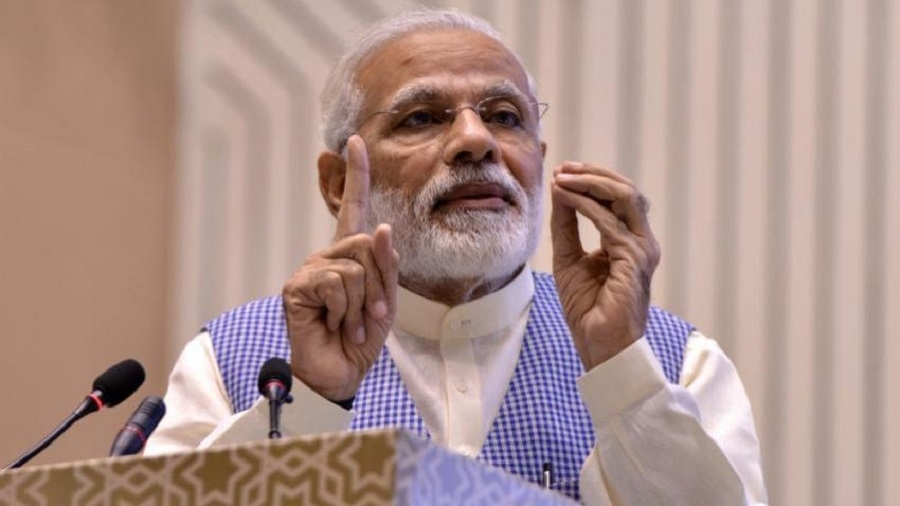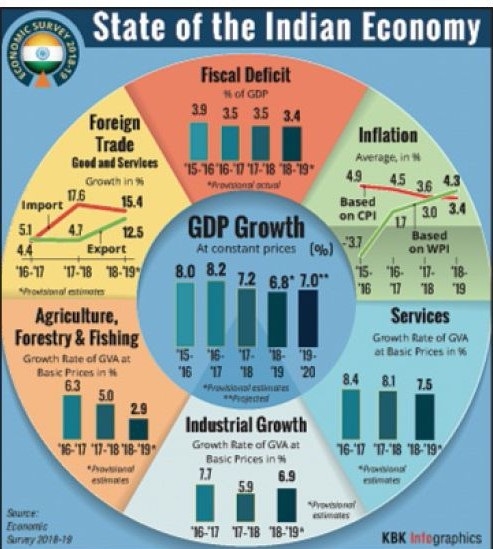‘7% GDP growth projected for 2019-20’
| Date :05-Jul-2019 |

NEW DELHI:
THE Government on Thursday projected the country’s GDP growth for 2019-20 at 7 per cent, up from five-year low of 6.8 per cent, on the back of anticipated pickup in investment and consumption. According to the Economic Survey 2018-19, tabled by Finance Minister Nirmala Sitharaman in Parliament, India continues to remain the fastest-growing major economy in the world in 2018-19, despite a slight moderation in its Gross Domestic Product (GDP) growth from 7.2 per cent in 2017-18 to 6.8 per cent in 2018-19. “India’s growth of real GDP has been high with average growth of 7.5 per cent in last five years (2014-15 onwards). The economy grew at 6.8 per cent in 2018-19, thereby experiencing some moderation in growth when compared to the previous year,” it said.

This moderation in growth momentum is mainly on account of lower growth in agriculture, trade, transport communication and services related to broadcasting among others, it said. During the last five years, India’s economy has performed well, it said, adding that the Government has ensured that the benefits of growth and macroeconomic stability reach the bottom of the pyramid by opening up several pathways for trickle-down.
“To achieve the objective of becoming a USD 5-trillion economy by 2024-25, as laid down by the Prime Minister, India needs to sustain a real GDP growth rate of 8 per cent,” it said. As per the survey, GDP growth for the year 2019-20 is projected at 7 per cent, reflecting a recovery in the economy after a deceleration in the growth momentum throughout 2018-19. “The growth in the economy is expected to pick up in 2019-20 as macroeconomic conditions continue to be stable while structural reforms initiated in the previous few years are continuing on course.
However, both downside risks and upside prospects persist in 2019-20,” it said. Investment rate, which was declining since 2011-12, seems to have bottomed out and is expected to pick up in consumer demand and bank lending, the survey said adding that economic slowdown impacting tax collections and rising state expenditure on farm sector may, however, put strains on the fiscal front. India is currently the sixth-largest economy in the world with a size of USD 2.7 trillion. It is expected to overtake Britain to become the fifth-largest next year. Authored by Chief Economic Adviser Krishnamurthy Subramanian, the Economic Survey said investment (especially private), is the ‘key driver’ that boosts demand, creates capacity, increases labour productivity, introduces new technology, allows creative destruction and generates jobs.
The survey, meanwhile, retained the fiscal deficit at 3.4 per cent of the GDP for the current fiscal, the same as projected in the revised estimate of the interim Budget 2019-20. However, general fiscal deficit - Centre and States combined - has been pegged at 5.8 per cent in 2018-19, down from 6.4 per cent in the previous fiscal. The Current Account Deficit (CAD) in the economy increased from 1.9 per cent of GDP in 2017-18 to 2.6 per cent in April-December 2018. “The widening of the CAD was largely on account of a higher trade deficit driven by rise in international crude oil prices (Indian basket). The trade deficit increased from USD 162.1 billion in 2017-18 to USD 184 billion 2018-19,” it said. The performance of banking sector has improved as bad loans declined in the last fiscal, but financial flows are constrained due to fall in money raised from capital markets and stress in the non-banking financial sector, the survey said. The monetary policy witnessed a U-turn over the last year. The benchmark policy rate was first hiked by 50 basis points (bps) and later reduced by 75 bps due to weaker than anticipated inflation, growth slowdown and softer international monetary conditions, Finance Minister Nirmala Sitharaman said while tabling the survey in Parliament.
Data “of the people, by the people, for the people” must become the mantra for the Government, which needs to view data as a ‘public good’ and make necessary investments, survey said. The key external debt indicators reflect that India’s external debt is not unsustainable, the survey said. According to the survey, India’s external debt was $521.1 billion at end-December 2018, which was 1.6 per cent lower than its level at end-March 2018. India’s inflation scenario transitioned from its high and volatile levels to a low and stable condition in the last five years.
“The economy witnessed a gradual transition from a period of high and variable inflation to more stable and low level of inflation in the last five years,” said the survey presented the Finance Minister Nirmala Sitharaman in Parliament on Thursday. The country must emphasise on Electric Vehicles (EVs) as these represent the next generation in sustainable mobility and appropriate policy measures are needed to lower the overall lifetime ownership costs to make them an attractive alternative to consumers, according to survey. The upcoming 5G technology is an opportunity for Indian industry players to reach out to global markets while building a digital payment, knowledge and services economy.
The Government has plans to make India 5G ready by 2020 and conduct spectrum auction for providing radiowaves for 5G this year. There is a need to address the “burgeoning food subsidy bill” in order to sustain the Government’s food security programme for the poor, the survey said. The Government, in its interim Budget presented in February, had pegged food subsidy bill at Rs 1,84,220 crore for 2019-20 as against Rs 1,71,298 crore last year. India’s economic growth will depend upon the ability to provide affordable, reliable and sustainable energy to citizens and the country is required to raise per capita energy consumption by at least 2.5 times to increase per capita income by USD 5000, the survey said.
The survey said India has the potential for USD 30 billion annual investment in renewables in next decade and even beyond that in view of its ambitious target of having 175 GW of clean energy by 2022. The Government is expected to further ease the Foreign Direct Investment (FDI) norms with a view to bridge the widening current account deficit (CAD), according to the Economic Survey 2018-19. India needs to have a well-designed minimum wage system, which would decrease wage inequality, alleviate poverty and bring inclusive growth especially at lower levels.
The Gross Tax to GDP ratio declined to 10.9 per cent in 2018-19 as Indirect Tax revenues fell short of Budget estimates by about 16 per cent, due to shortfall in Goods and Services Tax (GST) mop up, the survey said. India’s Met Department has projected less rains in some region which could affect the crop production in those areas. Expressing concern that India will be in the global hot spot for ‘water insecurity’ by 2050, it said the focus in agriculture should shift from ‘land productivity’ to ‘irrigation water productivity’. “Therefore, devising policies to incentivise farmers to adopt efficient ways of water use should become a national priority to avert the looming water crisis,” the survey added. The Economic Survey Thursday suggested reducing the number of holidays of courts, and appointing more judges to enhance productivity in the judiciary system, stating that delays in contract enforcement and disposal resolution are biggest hurdle to the ease of doing business in India.
Economic Survey outlines vision for $5 tn economy:PM
NEW DELHI:
PRAISING the Economic Survey 2018-19, Prime Minister Narendra Modi has said that the survey outlines a vision to make India a $5 trillion economy. “The #EconomicSurvey2019 outlines a vision to achieve a $5 Trillion economy,” the Prime Minister said in a tweet. He also said that the survey depicts gains from advancement in social sector, adoption of technology and energy security. A Finance Ministry statement said theme of survey is about enabling a shifting of gears towards sustained economic growth for objective of $5 trillion by 2024-25.
Economic Survey 2018-19 highlights
GDP growth pegged at 7 per cent in 2019-20, up from 6.8 per cent last fiscal
Growth in current fiscal to be driven by investment, consumption
Sustained 8 pc growth needed to become a USD 5-trillion economy by 2024-25
Huge political mandate augurs well for growth prospects n Investment is the ‘key driver’ of simultaneous growth in demand, jobs, exports & productivity
Green shoots in investment, visible pick-up in credit growth seen
Crude oil prices to decline in 2019-20, to push consumption
General Government fiscal deficit seen at 5.8 pc in 2018-19, against 6.4 per cent last fiscal
Projects imports to grow at 15.4 pc, exports at 12.5 pc for 2018-19
Projects 283.4 mn tonne of foodgrain production in 2018-19
Foreign exchange reserves at USD 422.2 billion in June 2019
Suggests policies to unshackle MSMEs to grow, create jobs and enhance productivity
Calls for reorienting policies to promote young firms which have the potential to become big, rather than small MSME firms which remain small
Flags need to prepare for ageing of the population; this neces sitates more healthcare investment, increasing retirement age in a phased manner
Highlights the immense potential of data of societal interest, says data should be ‘of the people, by people, for the people’
Legal reform, policy consistency, efficient labour markets and use of technology focus areas
Contract enforcement biggest constraint to improve Ease of Doing Business ranking; much of the problem is concentrated in the lower courts
Low pay and wage inequality remain serious obstacles towards achieving inclusive growth.
Policy changes needed to lower overall lifetime ownership costs and make electric vehicles an attractive alternative to conventional vehicles
Survey recommends harmonised overarching National Policy on Resource Efficiency.